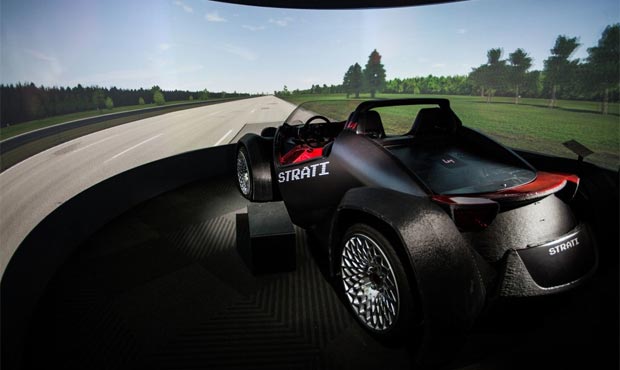Paul Allen revamps Living Computers Museum
Nov 17, 2016, 6:02 PM | Updated: 9:32 pm

The self-driving 3D printed car at The Living Computers Museum and Labs (Photo by Dario Impini)
(Photo by Dario Impini)
Museums are usually hands off affairs. You stand, you look, you ponder. But at Paul Allen’s Living Computers Museum and Labs they say the best way to experience a computer is to use it.
“When Paul Allen founded this museum, the idea was taking vintage computer systems, restoring them to operating condition and then making them available to the public,” says the museum’s executive director, Lath Carlson.
“So all of our vintage machines, which are often the only operative one in the world, we let people touch,” he said. “It creates some tension with other museum professionals as they come in here and go, ‘What do you mean? That’s the only one! How can you let people touch it?’ But what Paul understood is you can’t really understand a computer unless you can interact with it. It’s just a box of wires and metal if you can’t program it. If you can’t see what it’s doing. If you can’t see it respond to you.”
How the Bonsai Museum is bringing in millennials
The Living Computers Museum has been around for four years, but until now it only featured vintage technology. Now the entire first floor is dedicated to modern technology, featuring everything from robots to a display of virtual reality headsets.
“We start with VR back in 1939 with the first View-Master,” Carlson said. “That’s where the obsession with stereoscopic 3D vision starts and then it builds from there. So we have an amazing collection, about 25 head mounted displays. Primarily they’re from the 1980s and 1990s and going all the way up to HoloLens and things that are out today.”
The idea is to show progression; how ideas improve and evolve over time.
“You can’t present it like everyone working in computer science is just a genius and they come up with these brilliant ideas from nowhere and boom! they have a billion dollar company,” Carlson said. “Really, everybody is building on other people’s works. Just to show that this has been an evolution and it’s all been a building process.”
Behind the Living Computers Museum
Carlson says the hope is that the Living Computers Museum inspires people to get interested in computer science and engineering.
“A lot of the reason why people don’t go into computer science is they see it as people sitting at a computer crunching code all day,” he said. “When most people now, working in computer science, are not doing that. They’re thinking about user interface design, they’re thinking of how people are going to work with it, they’re working in very collaborative teams. They’re coming up with innovative ways to use technology”
“It’s a lot more about people plus technology than it is just the technology,” Carlson said. “That, if anything, is what we really tried to do with our approach here in the museum. Make it a place where you want to play with the technology and you’re not intimidated by it at all. Hopefully by creating that environment, we’ll get a more diverse group of people going into computer science and that’s really our mandate.”
One of the highlights of the museum is an electric self-driving car that was 3D printed on site in the span off 44 hours.
“The entire body was printed as one piece and then the fender is the second piece,” Carlson said. “And then they go in and they put in the electric motor. It’s incredibly strong and it also drives itself. So it has a steering wheel and pedals so you can manually drive it or have it go into autonomous mode, have it take you where you want. You can just punch in on a touchscreen your destination and pull your phone out and relax.”
The car is parked in front of a wraparound screen, so when you hop in the car and step on the gas, you feel like you’re driving through a virtual city. This is a car that’s on the market now, without the self-driving technology, and the museum reveals the price in the exhibit.
“People always want to know what things cost [in museums],” Carlson said. “They want to know what the Monet on the wall costs. So we just figured, put that front and center. So most of our exhibit labels will tell you the year the technology was introduced and how much it costs.”
The museum also features three educational labs for various training and workshops.
Paul Allen’s newly revamped Living Computers Museum and Labs opens Friday.













